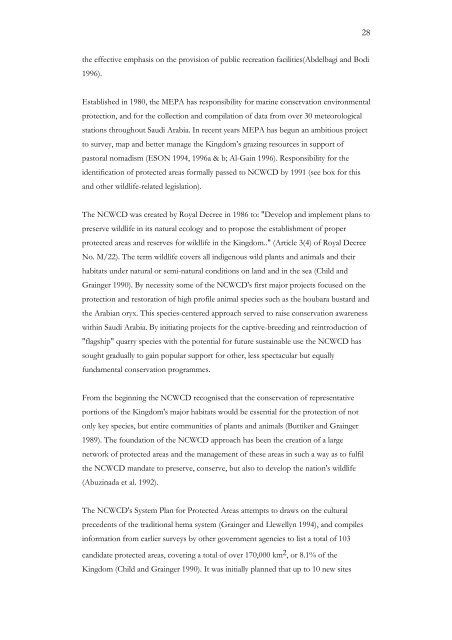The Unfenced Desert Towards a strategy for eco ... - Nwrc.gov.sa
The Unfenced Desert Towards a strategy for eco ... - Nwrc.gov.sa
The Unfenced Desert Towards a strategy for eco ... - Nwrc.gov.sa
You also want an ePaper? Increase the reach of your titles
YUMPU automatically turns print PDFs into web optimized ePapers that Google loves.
the effective emphasis on the provision of public recreation facilities(Abdelbagi and Bodi<br />
1996).<br />
Established in 1980, the MEPA has responsibility <strong>for</strong> marine conservation environmental<br />
protection, and <strong>for</strong> the collection and compilation of data from over 30 meteorological<br />
stations throughout Saudi Arabia. In recent years MEPA has begun an ambitious project<br />
to survey, map and better manage the Kingdom’s grazing resources in support of<br />
pastoral nomadism (ESON 1994, 1996a & b; Al-Gain 1996). Responsibility <strong>for</strong> the<br />
identification of protected areas <strong>for</strong>mally passed to NCWCD by 1991 (see box <strong>for</strong> this<br />
and other wildlife-related legislation).<br />
<strong>The</strong> NCWCD was created by Royal Decree in 1986 to: "Develop and implement plans to<br />
preserve wildlife in its natural <strong>eco</strong>logy and to propose the establishment of proper<br />
protected areas and reserves <strong>for</strong> wildlife in the Kingdom.." (Article 3(4) of Royal Decree<br />
No. M/22). <strong>The</strong> term wildlife covers all indigenous wild plants and animals and their<br />
habitats under natural or semi-natural conditions on land and in the sea (Child and<br />
Grainger 1990). By necessity some of the NCWCD's first major projects focused on the<br />
protection and restoration of high profile animal species such as the houbara bustard and<br />
the Arabian oryx. This species-centered approach served to raise conservation awareness<br />
within Saudi Arabia. By initiating projects <strong>for</strong> the captive-breeding and reintroduction of<br />
"flagship" quarry species with the potential <strong>for</strong> future sustainable use the NCWCD has<br />
sought gradually to gain popular support <strong>for</strong> other, less spectacular but equally<br />
fundamental conservation programmes.<br />
From the beginning the NCWCD r<strong>eco</strong>gnised that the conservation of representative<br />
portions of the Kingdom's major habitats would be essential <strong>for</strong> the protection of not<br />
only key species, but entire communities of plants and animals (Buttiker and Grainger<br />
1989). <strong>The</strong> foundation of the NCWCD approach has been the creation of a large<br />
network of protected areas and the management of these areas in such a way as to fulfil<br />
the NCWCD mandate to preserve, conserve, but also to develop the nation's wildlife<br />
(Abuzinada et al. 1992).<br />
<strong>The</strong> NCWCD's System Plan <strong>for</strong> Protected Areas attempts to draws on the cultural<br />
precedents of the traditional hema system (Grainger and Llewellyn 1994), and compiles<br />
in<strong>for</strong>mation from earlier surveys by other <strong>gov</strong>ernment agencies to list a total of 103<br />
candidate protected areas, covering a total of over 170,000 km2 , or 8.1% of the<br />
Kingdom (Child and Grainger 1990). It was initially planned that up to 10 new sites<br />
28

















